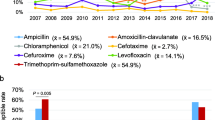Abstract
To describe the characteristics of adult invasive H. influenzae disease, 34 patients diagnosed at a single tertiary center between 2004 and 2017 were analyzed in a retrospective case series study. The annual estimated incidence was 0.1 cases/100.000 inhabitants. Dominant source of infection was pneumonia accompanied by sepsis (62%) and caused by nontypeable strains (74%) with low ampicillin resistance (14%). Survival (94%) and complication rates were high (35%). Main empirical treatments were ceftriaxone or levofloxacine.
Similar content being viewed by others
References
Ieven M, Coenen S, Loens K, Lammens C, Coenjaerts F, Vanderstraeten A, et al. Aetiology of lower respiratory tract infection in adults in primary care: a prospective study in 11 European countries. Clin Microbiol Infect. 2018;2–7. https://doi.org/10.1016/j.cmi.2018.02.004
Shimol SB, Dagan R. Haemophilus influenzae: still a relevant invasive pathogen. Isr Med Assoc J. 2012;14:432–4.
Falla T, Crook D, Brophy L, Maskell D, Kroll J, Moxon E. PCR for capsular typing of Haemophilus influenzae. J Clin Microbiol. 1994;32:2382–6.
National Bacteriological Surveillance Management Team. NBS Annual Reports, 2005–2016 [Internet]. National Center for Epidemiology (Budapest, Hungary). 2017. Available from: http://www.oek.hu/oek.web?to=2479&nid=505&pid=1&lang=hun. Accessed 15 Jan 2018.
Ladhani S, Slack MP, Heath PT, Von Gottberg A, Chandra M, Ramsay ME, et al. Invasive Haemophilus influenzae disease, Europe, 1996–2006. Emerg Infect Dis. 2010;16:455–63.
Whittaker R, Economopoulou A, Dias JG, Bancroft E, Ramliden M, Celentano LP. Epidemiology of invasive Haemophilus influenzae disease, Europe, 2007–2014. Emerg Infect Dis. 2017;23:396–404.
MacNeil JR, Cohn AC, Farley M, Mair R, Baumbach J, Bennett N, et al. Current epidemiology and trends in invasive Haemophilus influenzae disease—United States, 1989–2008. Clin Infect Dis. 2011;53:1230–6.
Puig C, Grau I, Marti S, Tubau F, Calatayud L, Pallares R, et al. Clinical and molecular epidemiology of Haemophilus influenzae causing invasive disease in adult patients. PLoS One. 2014;9:1–7.
Blain A, MacNeil J, Wang X, Bennett N, Farley M, Harrison LH, et al. Invasive Haemophilus influenzae disease in adults ≥ 65 years, United States, 2011. Open Forum Infect Dis. 2014;1:ofu044.
Kiliç H, Akyol S, Parkan ÕM, Dinç G, Sav H, Aydemir G. Molecular characterization and antibiotic susceptibility of Haemophilus influenzae clinical isolates. Inf Med. 2017;25:27–32.
Bae S, Lee J, Lee J, Kim E, Lee S, Yu J, et al. Antimicrobial resistance in Haemophilus influenzae respiratory tract isolates in Korea: results of a nationwide acute respiratory infections surveillance. Antimicrob Agents Chemother. 2010;54:65–71.
Ministry of Human Capacities National Public Health and Medical Officer Service Department of Hospital Hygiene and Epidemiology Surveillance. Annual reports on the national epidemiological situation and outbreaks, 2001–2016 [Internet]. National Center for Epidemiology (Budapest, Hungary). 2017. http://www.oek.hu/oek.web?to=2475,2465&nid=509&pid=1&lang=hun. Accessed 15 Jan 2018.
Van Wessel K, Rodenburg GD, Veenhoven RH, Spanjaard L, Van Der Ende A, Sanders EAM. Nontypeable Haemophilus influenzae invasive disease in the Netherlands: a retrospective surveillance study 2001–2008. Clin Infect Dis. 2011;53:8–12.
Laupland KB, Schønheyder HC, Østergaard C, Knudsen JD, Valiquette L, Galbraith J, et al. Epidemiology of Haemophilus influenzae Bacteremia: a multi-national population-based assessment. J Infect. 2011;62:142–8.
Acknowledgements
BGSz received the EFOP-3.6.3-VEKOP-16-2017-00009 doctorate grant as PhD student of EO. The funding source had no involvement in the preparation, writing, interpretation, or submission of the article. The study itself did not receive any external funding.
Author information
Authors and Affiliations
Corresponding author
Ethics declarations
Conflict of interest
The authors declare no conflicts of interest regarding this study.
Rights and permissions
About this article
Cite this article
Szabo, B.G., Lenart, K.S., Tirczka, T. et al. Clinical and microbiological characteristics of adult invasive Haemophilus influenzae infections: results of a 14-year single-center experience from Hungary. Infection 46, 855–860 (2018). https://doi.org/10.1007/s15010-018-1213-6
Received:
Accepted:
Published:
Issue Date:
DOI: https://doi.org/10.1007/s15010-018-1213-6




